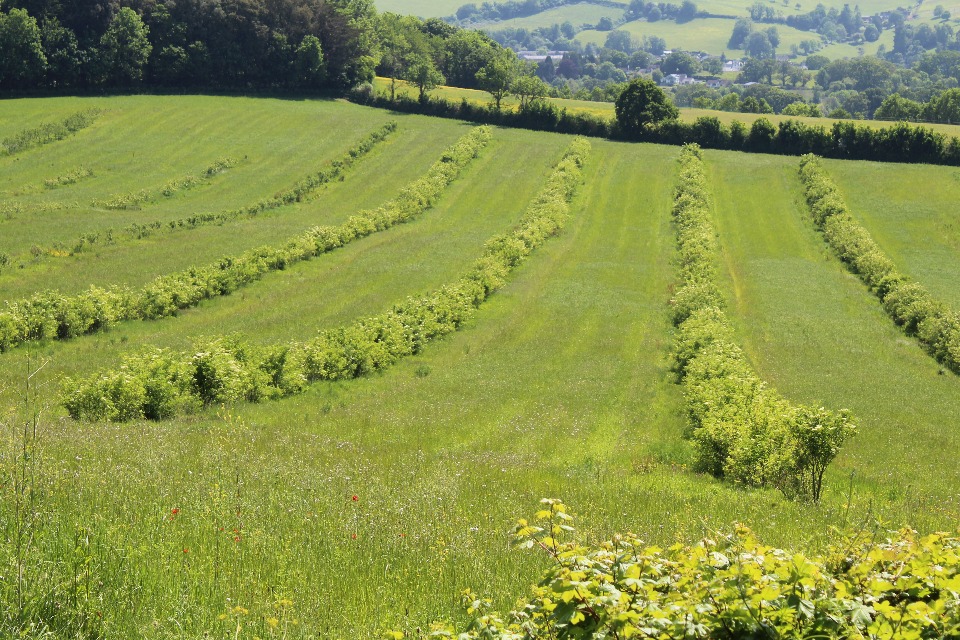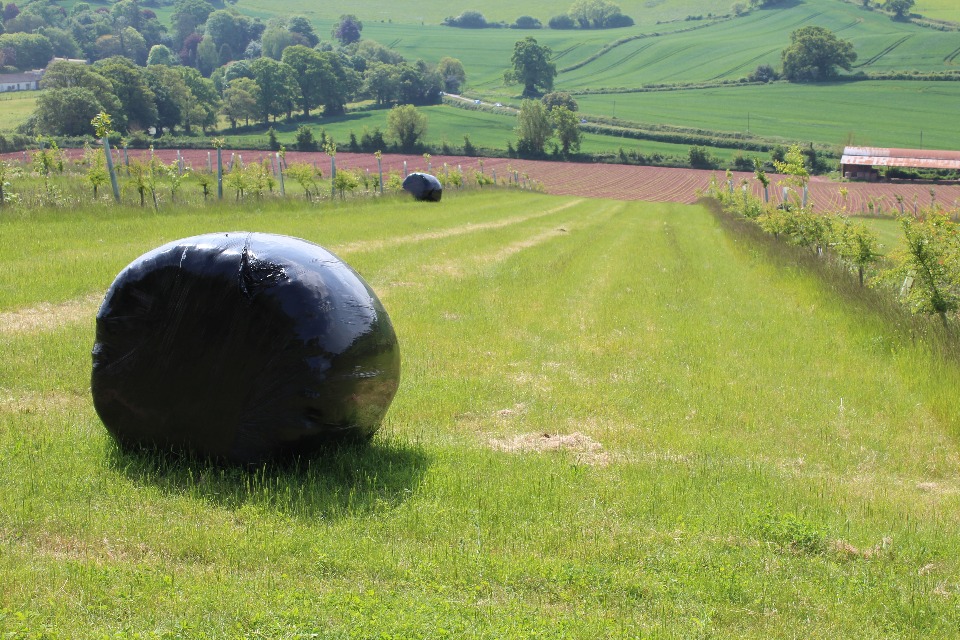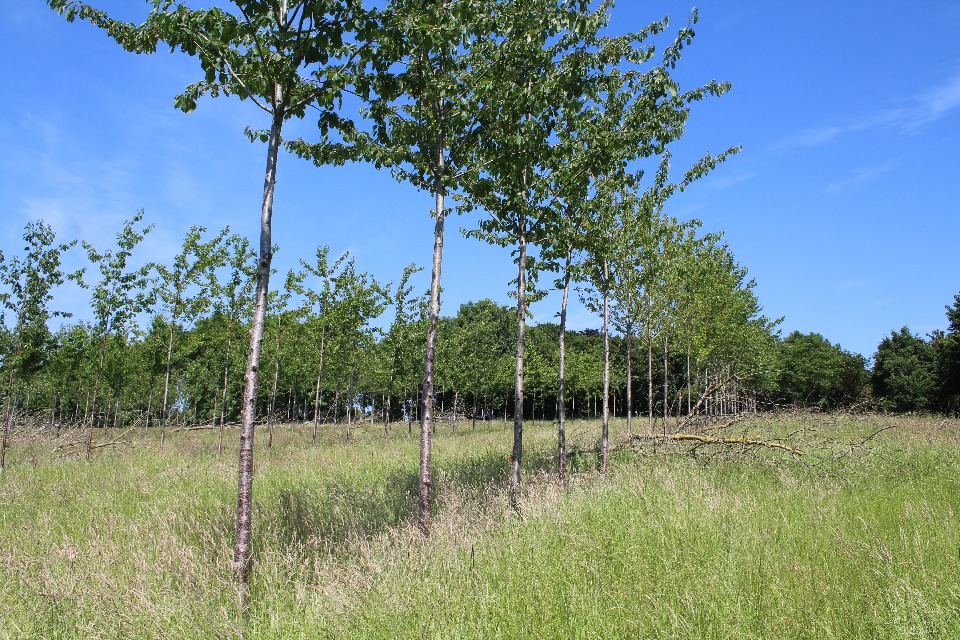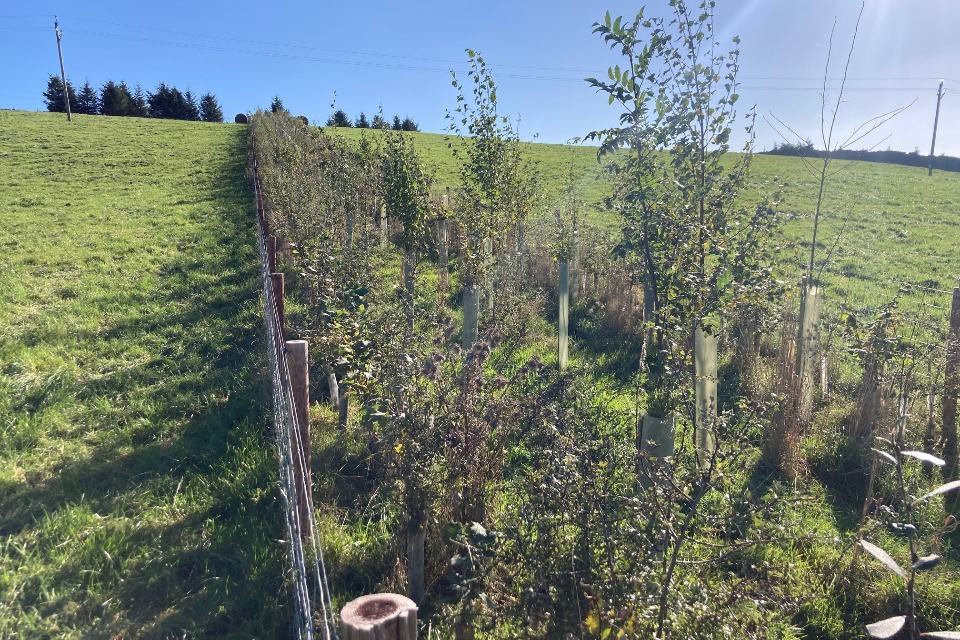A guide to agroforestry
An introduction to agroforestry including the benefits and definitions.
Applies to England
What is agroforestry?
Agroforestry is the integration of trees into the farming system, while maintaining or enhancing the farm’s main agricultural output.
Benefits of agroforestry
There are many ways that agroforestry can enhance your farm’s main production and overall outputs:
- enhanced soil health and protection from extreme weather can increase crop production
- trees can shelter livestock and crops from extreme weather conditions, such as sun, wind and heavy rain
- trees can bring extra income streams, from wood-based products or fruit and nut produce
Agroforestry also benefits the environment by protecting soil, rivers and biodiversity, capturing and storing carbon, as well as providing cleaner air and water. These benefits can support the long-term resilience of your farm business to climate change.

Agroforestry at Dartington Estate in Devon
Different types of agroforestry
There are 2 broad categories of agroforestry: ‘in-field’ and ‘around field’.
In-field agroforestry
Trees are planted in the field to benefit crops and livestock.
The main types of in-field agroforestry are:
- silvoarable agroforestry: trees are planted at wide spacings and are intercropped with arable crops
- silvopastoral agroforestry: trees are combined with forage grassland and livestock production
- wood pasture and traditional orchards: priority habitats managed in a low-intensity way for biodiversity
Planting arrangements

An 18 month old agroforestry site on a Devon farm. Silage has been collected on site
There is a variety of planting arrangements that can be used for in-field agroforestry. You should decide what works best for your circumstances. For example, silvoarable tree planting arrangements traditionally use widely spaced rows of trees, but you could use this design in a silvopastoral setting, especially when managing grass for grazing and silage cutting. Common formations include:
-
grids and row formations: trees are arranged formally in grids or rows on arable and grazing land, allowing farmers to maximise traditional farming activity and allow space for machinery. It can also prevent wind affected soil erosion
-
irregular formation: more irregular, or random, tree arrangements are used in grazing systems, especially in upland landscapes and where visual impact might be a consideration

A row of pruned cherry trees
Management
Pruning and high pruning regularly helps counteract the effects of branch growth. Managing the tree canopy will reduce the competition for light with crops and, grass, and allow easy machinery access.
By removing lower branches, timber quality will be improved by providing a clean, knot-free length of timber.
Around field agroforestry
Trees and woodland provide features around fields to assist with farming practice.
Hedgerow trees
Adding more trees to hedgerows increases tree canopy cover across the farm.
Regular pruning allows more daylight to reach the grass sward or crops. We recommend tree pruning from an early age to avoid negative impacts on farming and machinery access, and increase the potential for better timber.

Tree hedges in Exmoor
Windbreaks and wider hedges
Trees planted in a linear format, on the edge of a field to reduce wind speed, protect crops and livestock and reduce erosion. Usually, 5 to 10 metre-wide hedges or windbreaks with a core of larger trees, flanked by smaller shrubs. They can have edible plant species for livestock to graze on at the edges, giving them access to additional minerals and nutrients.
Wide hedges, or windbreaks provide practical biosecurity solutions including:
- reducing nose to nose contact for livestock
- useful on farm boundaries

A 5 metre wide hedge with young trees
Shelterbelts
Similar to windbreaks, shelterbelts are planted in a linear formation on the windward edge of a field to reduce wind speed, but are generally planted in a more extensive manner or in a connected network.
These networks can provide greater shelter across the land and provide effective wildlife corridors for biodiversity.
Riparian buffer
Trees that are planted between agricultural land and watercourses such as streams, rivers and lakes to act as buffers to protect water quality.
Open grown trees (around and in-field)
More open tree planting at very low densities, formally or informally arranged. These might be for shade and shelter for livestock, or as boundary or feature markers.
Grants supporting agroforestry
See the full list of agroforestry funding and grants.
Where to find more information
The tree species guide for UK agroforestry systems details 33 tree species best suited for farms.
The Farm Woodland Forum aims to share and promote best practices for farming with trees.
The Defra farming blog provides up-to-date information on Environmental Land Management schemes.
The Agroforestry Handbook provides an essential guide to agroforestry and how to implement these systems on your farm.
If you are looking for a local nursery, the tree nurseries directory (agroforestry) includes nurseries growing fruit and nut trees, usually from whip to standard size.
If you would like to discuss agroforestry with us, including whether your land is eligible for SFI agroforestry, email: GRNationalTeam@forestrycommission.gov.uk
To help your email reach the relevant agroforestry Woodland Officer for your area, title your email as: Agroforestry: county name, followed by your postcode.
Find more resources at:
- Agroforestry: an Illustrated guide
- Expanding agroforestry: a tree species guide for agroforestry in the UK - Forest Research
- Agroforestry and woodland cover scenarios explained
Discover the benefits and practicalities of agroforestry in this three-part podcast mini-series from RuralPod Media’s Meet the Farmers, produced in collaboration with the Forestry Commission.
This video by Catchment Sensitive Farming shows how FarmEco added trees to their farming system, and includes advice on getting started with agroforestry:
Watch the video: Making agroforestry work for you.
Further information can be found at:
Updates to this page
-
Added links to Meet the Farmers podcast and the Farm Woodland Forum.
-
Added a link to the 'tree nurseries directory (agroforestry)'.
-
Added a link to a video on agroforestry.
-
Added a link the the agroforestry grants and funding page.
-
Added a link to tree species guide for UK agroforestry systems.
-
Added a link to the SFI Agroforestry data layer.
-
First published.